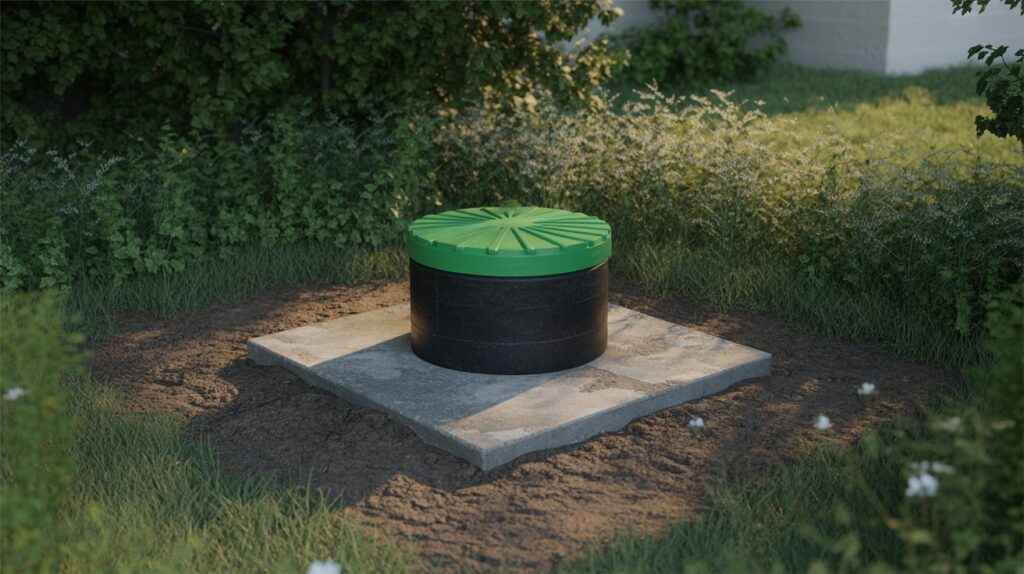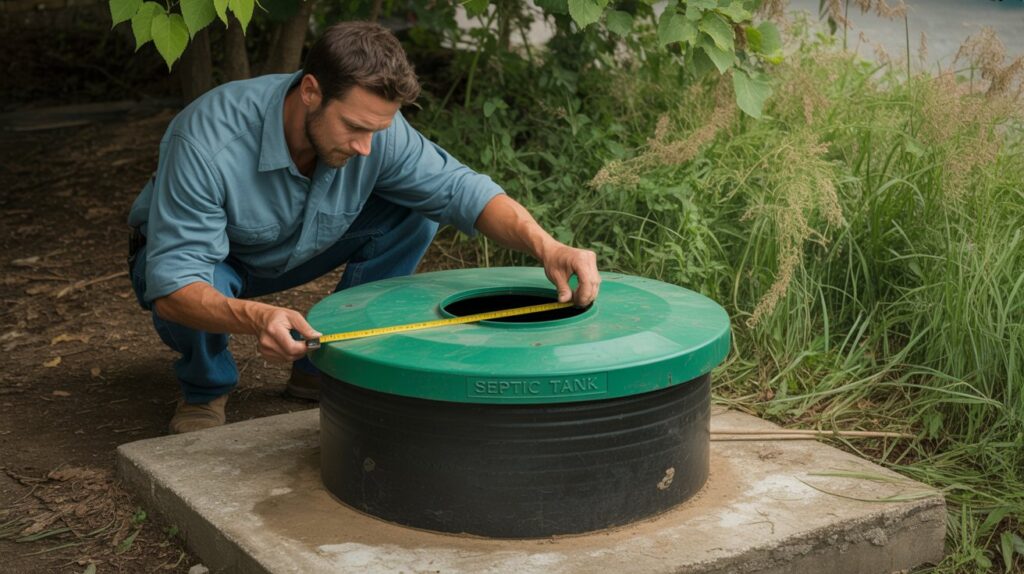Are you aware of the hidden costs associated with maintaining your septic system? For many homeowners, accessing the septic tank lid can be a cumbersome and expensive task. A septic tank riser installation can be a cost-efficient solution to this problem.
A septic tank riser makes it easier to access the septic tank lid, reducing the need for costly excavations. According to Septic Connection, a reliable septic service provider is essential for homeowners with septic systems, ensuring that installations are done correctly and safely.
Key Takeaways
- Understanding the role of a septic tank riser in simplifying maintenance.
- Recognizing the benefits of a septic tank riser installation.
- Importance of hiring a reliable septic service provider.
- Cost savings associated with septic tank risers.
- Ease of access to the septic tank lid with a riser.
What Is a Septic Tank Riser and Why Do You Need One?
A septic tank riser is more than just a pipe; it’s a vital component of your septic system. It provides ground-level access to the septic tank’s lid, making maintenance and inspections significantly easier.
Septic tank risers are typically made of durable materials like concrete or plastic, designed to withstand the elements and last for many years. Understanding the function and purpose of these risers is essential for homeowners with septic systems.
The Function and Purpose of Septic Tank Risers
The primary function of a septic tank riser is to extend the access point of the septic tank to the surface, allowing for easier maintenance and pumping. This is particularly important for tanks that are buried deep underground. By bringing the access point to ground level, risers simplify the process of inspecting and servicing the septic tank.
Risers are crucial for:
- Simplifying maintenance and inspections
- Reducing the cost of pumping the septic tank
- Enhancing safety by minimizing the need for deep excavations
Components of a Complete Riser System
A complete riser system consists of several key components. These include the riser pipe itself, the lid or cover, and any necessary adapters or seals. The materials used for these components can vary, with concrete and plastic being the most common.
| Component | Material Options | Purpose |
|---|---|---|
| Riser Pipe | Concrete, Plastic | Extends access point to surface |
| Lid/Cover | Concrete, Plastic, Metal | Seals the riser and provides access |
| Adapters/Seals | Rubber, Plastic | Ensures a watertight connection |
By understanding the components and function of septic tank risers, homeowners can better appreciate their importance in maintaining a healthy and functional septic system.
Benefits of Installing Septic Tank Risers for Homeowners
Homeowners with septic systems can greatly benefit from the installation of a septic tank riser. These devices provide easier access to the septic tank, reduce maintenance costs, and can even impact property value. By understanding the advantages of septic tank risers, homeowners can make informed decisions about their septic systems.
Easier Access for Maintenance and Pumping
One of the primary benefits of septic tank risers is the ease of access they provide for maintenance and pumping. By bringing the access point to the surface, risers eliminate the need for deep excavations, making inspections and pumping quicker and more cost-effective. As a result, homeowners can save time and money during future septic system maintenance.
Cost Savings Over Time
Installing a septic tank riser can lead to significant cost savings over time. According to industry experts, “A well-installed septic tank riser can reduce maintenance costs by up to 50%.” By reducing the complexity and cost of individual maintenance visits, risers provide a valuable long-term investment for homeowners.
Property Value and Inspection Considerations
Septic tank risers can also play a role in property value and inspection considerations. A properly installed riser can make a positive impression during property inspections, potentially increasing the property’s value. Furthermore, having a riser in place demonstrates a proactive approach to septic system maintenance, which can be a selling point for potential buyers.
Are Septic Tank Risers Required or Just Recommended?
Understanding whether septic tank risers are required or just recommended involves delving into state and local code requirements. The regulations surrounding septic tank risers vary significantly across different regions, making it essential for homeowners to familiarize themselves with local laws.
State and Local Code Requirements
State and local code requirements play a crucial role in determining the necessity of septic tank risers. These regulations are often designed to ensure that septic systems are properly maintained and do not pose a risk to public health or the environment. For instance, some jurisdictions may require risers to be installed to facilitate easier access for maintenance and inspections. Homeowners should consult their local health department or a septic professional to understand the specific requirements in their area.
| State | Requirement for Risers | Additional Notes |
|---|---|---|
| California | Mandatory for new installations | Must comply with California Code Title 24 |
| Florida | Recommended but not mandatory | Local codes may vary; check with local authorities |
| New York | Required for property transfers | Must meet New York State Department of Health standards |
When Risers Become Mandatory During Property Transfers
During property transfers, the requirement for septic tank risers can become more stringent. In many jurisdictions, risers are required to ensure that the septic system is accessible for inspection and maintenance. This is particularly important as it allows potential buyers to assess the condition of the septic system, thereby reducing the risk of future disputes or costly repairs. Homeowners should be aware that failing to comply with these requirements can lead to delays or even cancellation of the property transfer.
Comparing Septic Tank Riser Materials
Septic tank risers are available in various materials, each with its unique benefits and drawbacks. The choice of material can significantly affect the durability, installation process, and overall cost of the septic system.
Concrete Risers: Durability and Installation Challenges
Concrete risers are known for their durability and long lifespan. They can withstand heavy loads and are less likely to be damaged by environmental factors. However, they can be challenging to install due to their weight and size.
PVC and Plastic Risers: Lightweight and Versatility
PVC and plastic risers, on the other hand, are lightweight and easier to install. They are also resistant to corrosion and can be more cost-effective. However, they may not be as durable as concrete risers and can be prone to damage from UV exposure.
Are Concrete Septic Tank Risers Better Than Plastic?
The choice between concrete and plastic risers depends on several factors, including budget, installation requirements, and personal preference. Here’s a comparison table:
| Material | Durability | Installation Ease | Cost |
|---|---|---|---|
| Concrete | High | Difficult | Higher |
| PVC/Plastic | Medium | Easy | Lower |

Ultimately, the decision should be based on a thorough assessment of your specific needs and circumstances. Consulting with a professional can help determine the most suitable material for your septic tank riser.
How Many Risers Should Your Septic Tank Have?
The number of risers your septic tank requires depends on several factors, including system size and configuration. A well-designed riser system is crucial for easy maintenance and ensuring the longevity of your septic system.
Single vs. Multiple Access Points
When considering septic tank risers, one of the key decisions is whether to opt for a single access point or multiple access points. Single access points are simpler and less expensive to install, making them suitable for smaller systems or those with straightforward configurations. On the other hand, multiple access points provide greater flexibility and ease of maintenance, especially for larger or more complex septic systems.
Determining the Right Configuration for Your System
To determine the right configuration, consider factors such as the size of your septic tank, the depth at which it’s buried, and local regulations regarding septic system maintenance. Consulting with a professional can help you decide on the optimal number of risers for your specific situation, ensuring compliance with local codes and efficient system operation.
Professional vs. DIY Septic Tank Riser Installation
When it comes to septic tank riser installation, homeowners often face a crucial decision: to hire a professional or take the DIY route. Both options have their advantages and disadvantages, which are important to consider to ensure the longevity and efficiency of your septic system.
When to Call a Professional Installer
While DIY installation is possible, there are situations where calling a professional is the best choice. If your septic system is complex or you’re unsure about any aspect of the installation process, it’s recommended to hire a professional. They have the necessary experience and equipment to handle complicated installations and ensure that the job is done correctly.
Step-by-Step DIY Installation Process
For those who decide to go the DIY route, here’s a basic step-by-step guide:
- Prepare the site by clearing any debris around the septic tank.
- Measure the depth of the tank to determine the correct riser size.
- Place the riser over the tank, ensuring it’s centered and level.
- Connect the riser to the tank according to the manufacturer’s instructions.
- Backfill around the riser, compacting the soil to prevent settling.
It’s crucial to follow the manufacturer’s instructions and local regulations during the installation process.
Tools and Materials Needed for Installation
The tools and materials required may vary depending on the type of riser and the specifics of your septic system. Commonly needed items include:
- Riser components (riser ring, lid, etc.)
- Sealants and adhesives
- Shovel and other excavation tools
- Leveling tools
In conclusion, whether you choose professional or DIY installation for your septic tank riser, it’s essential to understand the process and requirements. By doing so, you can ensure that your septic system operates efficiently and effectively.
Installing Different Types of Septic Tank Risers
The process of installing septic tank risers varies depending on the material used. Different materials offer unique benefits and challenges, and understanding these differences is crucial for a successful installation.
How to Install PVC Septic Tank Risers
Installing PVC septic tank risers involves several steps. First, ensure the PVC riser is compatible with your septic tank. Next, excavate around the tank to access the access ports. Use a PVC primer and cement to secure the riser to the tank, ensuring a watertight seal. Finally, backfill the excavated area, taking care not to damage the riser or tank.
How to Install Concrete Septic Tank Risers
Concrete septic tank risers require a slightly different installation process. Begin by preparing the site around the septic tank, ensuring it is clear of debris. Then, place the concrete riser over the access port, ensuring it is level and secure. Use a concrete sealant to fill any gaps and prevent leakage. Finally, backfill around the riser, compacting the soil to prevent settling or shifting.
Regardless of the material, proper installation is key to ensuring the longevity and functionality of your septic system.
Septic Tank Riser Specifications and Modifications
Proper septic tank riser specifications are vital for maintaining a well-functioning septic system and preventing potential environmental hazards. Understanding these specifications helps homeowners make informed decisions about their septic systems.
Standard Sizes and Heights
Septic tank risers are manufactured in various standard sizes to accommodate different septic tank configurations. Typically, risers range from 6 to 24 inches in height and are available in different diameters to fit various tank openings. Standardization ensures compatibility with most septic tanks, but it’s crucial to measure your tank’s access ports to select the correct riser size.
How to Measure for the Right Fit
Measuring for a septic tank riser involves determining the diameter of the tank’s access port and assessing the depth of the tank relative to the ground surface. Accurate measurements are critical to ensure a proper fit and to prevent leaks or other issues. Homeowners should measure the diameter of the access port and the distance from the top of the tank to the ground level to choose the appropriate riser height.

Can You Stack, Cut, or Extend Septic Tank Risers?
Yes, septic tank risers can be stacked, cut, or extended to meet specific installation requirements. Stacking risers allows for greater flexibility in achieving the desired height, while cutting or extending them can accommodate unique site conditions. However, any modifications should be done carefully to maintain the structural integrity and watertight seal of the riser system.
How Far Above Ground Should a Septic Tank Riser Be?
The height at which a septic tank riser should be installed above ground depends on local regulations and site-specific conditions. Generally, risers should be installed so that the lid is at or slightly above ground level, facilitating easy access for maintenance and inspections while minimizing the risk of surface water intrusion.
By understanding septic tank riser specifications and how to modify them as needed, homeowners can ensure their septic systems operate efficiently and effectively, reducing the risk of costly repairs or environmental damage.
Maintenance and Aesthetics of Septic Tank Risers
Proper maintenance of septic tank risers is crucial for their longevity and functionality. Regular upkeep ensures that the risers continue to provide easy access for maintenance and pumping, ultimately saving homeowners time and money.
Properly Sealing Septic Tank Risers
Sealing septic tank risers is essential to prevent groundwater from entering the tank and to keep wastewater from leaking out. Use a high-quality sealant around the lid and any joints to maintain a watertight seal. Proper sealing also helps prevent unwanted odors and pests.
Lid Security and Child Safety Considerations
Ensuring the security of septic tank riser lids is vital, especially for homes with children. Installing locking mechanisms or heavy-duty lids can prevent accidental openings and enhance safety. Regularly inspect the lids for any signs of damage or wear.
Creative Ways to Cover and Disguise Septic Tank Risers
Homeowners can enhance their yard’s aesthetics by creatively covering or disguising septic tank risers. Options include decorative rock gardens, artificial turf, or even building a small enclosure that blends with the surrounding landscape. As one expert notes, “A well-disguised septic riser can be a seamless part of your yard’s design.”
Cost Considerations for Septic Tank Risers
The cost considerations for septic tank risers involve several factors, including material and installation expenses. Homeowners must consider these costs when deciding to install or replace a septic tank riser.
Material and Supply Costs
The cost of septic tank risers varies significantly based on the material used. Concrete risers are generally more expensive than PVC or plastic risers, but they offer greater durability and longevity. The average cost for concrete risers can range from $200 to $500, while PVC risers may cost between $100 to $300.
When selecting a material, homeowners should consider not only the upfront cost but also the long-term benefits and potential maintenance costs associated with each type of riser.
Installation and Replacement Expenses
Installation costs for septic tank risers can vary depending on the complexity of the job and the rates charged by local contractors. On average, homeowners can expect to pay between $500 to $1,000 for professional installation, including labor and materials.
Replacement expenses should also be considered, as risers may need to be replaced over time due to wear and tear or damage. Regular maintenance can help extend the lifespan of a septic tank riser.
Are Septic Tank Risers Worth the Investment?
Despite the initial cost, septic tank risers are a worthwhile investment for many homeowners. They provide easier access for maintenance and pumping, potentially reducing long-term costs associated with septic system upkeep.
By considering both the material costs and installation expenses, homeowners can make an informed decision about whether a septic tank riser is a valuable addition to their septic system.
Conclusion: Making the Right Decision for Your Septic System
Installing a septic tank riser can significantly improve septic system maintenance by providing easier access for pumping and inspections. As discussed, risers come in different materials, such as concrete and PVC, each with its own set of benefits and considerations.
When making a septic tank riser decision, consider factors like durability, cost, and local regulations. Proper installation, whether DIY or professional, is crucial for the longevity and effectiveness of the riser. Regular maintenance and inspections will also ensure that your septic system operates smoothly.
By understanding the role of septic tank risers in septic system maintenance, homeowners can make informed decisions that protect their property and the environment. A well-maintained septic system is not only a regulatory requirement but also a valuable investment in your home’s infrastructure.

